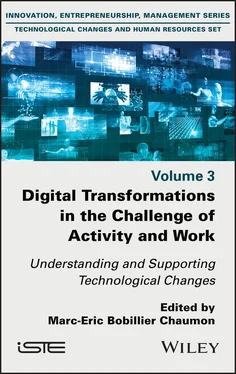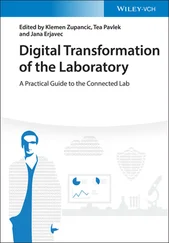Digital Transformations in the Challenge of Activity and Work
Здесь есть возможность читать онлайн «Digital Transformations in the Challenge of Activity and Work» — ознакомительный отрывок электронной книги совершенно бесплатно, а после прочтения отрывка купить полную версию. В некоторых случаях можно слушать аудио, скачать через торрент в формате fb2 и присутствует краткое содержание. Жанр: unrecognised, на английском языке. Описание произведения, (предисловие) а так же отзывы посетителей доступны на портале библиотеки ЛибКат.
- Название:Digital Transformations in the Challenge of Activity and Work
- Автор:
- Жанр:
- Год:неизвестен
- ISBN:нет данных
- Рейтинг книги:4 / 5. Голосов: 1
-
Избранное:Добавить в избранное
- Отзывы:
-
Ваша оценка:
- 80
- 1
- 2
- 3
- 4
- 5
Digital Transformations in the Challenge of Activity and Work: краткое содержание, описание и аннотация
Предлагаем к чтению аннотацию, описание, краткое содержание или предисловие (зависит от того, что написал сам автор книги «Digital Transformations in the Challenge of Activity and Work»). Если вы не нашли необходимую информацию о книге — напишите в комментариях, мы постараемся отыскать её.
Digital Transformations in the Challenge of Activity and Work — читать онлайн ознакомительный отрывок
Ниже представлен текст книги, разбитый по страницам. Система сохранения места последней прочитанной страницы, позволяет с удобством читать онлайн бесплатно книгу «Digital Transformations in the Challenge of Activity and Work», без необходимости каждый раз заново искать на чём Вы остановились. Поставьте закладку, и сможете в любой момент перейти на страницу, на которой закончили чтение.
Интервал:
Закладка:
ISTE Ltd
27-37 St George’s Road
London SW19 4EU
UK
www.iste.co.uk
John Wiley & Sons, Inc.
111 River Street
Hoboken, NJ 07030
USA
www.wiley.com
© ISTE Ltd 2021
The rights of Marc-Eric Bobillier Chaumon to be identified as the author of this work have been asserted by him in accordance with the Copyright, Designs and Patents Act 1988.
Library of Congress Control Number: 2020946633
British Library Cataloguing-in-Publication Data
A CIP record for this book is available from the British Library
ISBN 978-1-78630-529-9
Introduction
There has been an acceleration in technological change within the workplace. This is because innovations and the deployment of technical solutions are multiplying ( AI , robotization , immersive environment , Big Data , collaborative platforms , factory of the future , etc.). At best, the implementation of these new devices provokes simple transfers of use and learning (which are iterative or incremental technologies), and, at worst, they provoke real disruptions in use (which are disruptive technologies) (Bobillier Chaumon 2016). These can require a profound rethinking of the user experience, which can cause employees to fail and make it more difficult for them to carry out their activity. Therefore, new organizational and socio-cognitive models are required, as the devices call for alternative ways of thinking, doing and collaborating at work.
Professional activity thus depends less and less on the direct intervention of individuals in terms of the object of work than on their actions within these digital work environments, that is, on technological artifacts that mediate this activity. This distancing phenomenon is consubstantial with the quality of the “human–machine” systems used: if a system is complex to use (i.e. designed with an insufficient level of usability) or if it is difficult to attribute meaning to this technical artifact to make it a truly useful and enabling instrument for one’s activity (notion of situated acceptance), the individual can be expected to experience difficulties in carrying out work in which he or she recognizes himself or herself and for which he or she is recognized. There is therefore a link between successful technologies and successful work, between a good quality technological environment and a good quality of work, and between the benefit of appropriate technical environments and the well-being of their users.
New ways of working are also accompanying the deployment of these emerging technologies: dematerialization of work processes, design of dynamic work spaces, automation of intellectual tasks, and the renewal of human–machine collaboration modes with (high-level) tasks that are delegated to systems, distributed among several actors and broken down into multiple spaces/times (nomadism, home office, coworking). These new ways of acting also correspond to new ways of suffering, which are expressed by cognitive and psychic loads of a new order and by potential socio-professional and organizational constraints (obsolescence of skills, renewal of professions, etc.).
While technologies can therefore re-enhance work and re-qualify the individual, they can also contribute to distorting the activity and divesting the subject of everything that make sense to them: in their professional practices and ties as well as in their room for maneuver and relationship with work. The dematerialization of activity can therefore be to the detriment of the employee and their work. This is because ICTs are implemented to either replace the individual or appropriate that which represents the core of their activity: that which has meaning and makes sense. However, these tools imply reconfigurations and requirements that destabilize work and weaken the individuals and collectives in place. The question of introducing ICTs and their constant renewal in organizations therefore fundamentally refers to the place and role that these devices play in the activity and its implementation conditions (factors of occupational health and well-being), as well as the way in which human factor specialists (occupational psychologists, sociologists, ergonomists, etc.) can grasp them in their interventions.
Considered as both a current and prospective reflection attempting to grasp the logic and modalities of the digital transformations taking place, this book has several goals:
1 1) to take stock of the current situation and define precisely what these new technologies and new working methods are that are being deployed in companies;
2 2) to understand the role they can play in organizational effectiveness and human efficiency;
3 3) to discuss the role of these technologies in the development (or prevention) of activity and their potential impact on the conditions for exercising the activity, the sources of well-being and the quality of life at work (occupational health);
4 4) to reflect on the approaches and modalities of support for these digital transformations, based on an anthropocentric, participatory and inclusive approach.
A total of 18 contributions provide epistemological support (from a theoretical and methodological point of view) and empirical illustrations (from field surveys) for these lines of thought. They come from teacher-researchers and practitioners who have been conducting interventions on the deployment of technologies in work organizations and consider the analysis and support of these digital transformations.
These perspectives provide multidisciplinary and complementary insights – in the field of occupational psychology, ergonomic psychology, ergonomics, sociology of uses, management sciences, etc. – on how these technologies are transforming work systems and how they can be better managed.
Thus, conceived both as a work of analysis and reflection on the socio-technical changes affecting the world of work in the future and in the making, and also as a handbook for understanding the major technological innovations and the approaches to support digital transformations in progress, each chapter – grouped into four main parts – enriches our understanding of the dynamics at work.
1) The first part provides an overview of the digital transformations and the various emerging technologies that are spreading throughout organizations.
Chapter 1by Marc-Eric Bobillier Chaumonprovides an overview of the various emerging technologies that are gradually being seen in companies, and discusses their paradoxical uses and impacts on work. Bobillier Chaumon also discusses how he believes the human and social sciences should accompany the design and deployment of these technical innovations so that they support business and promote the well-being of employees. Chapter 2by Nadia Barville-Deromasand Marc-Eric Bobillier Chaumonfocuses on the topic of collaborative technologies, and more specifically on the corporate digital social networks that are being massively spread throughout organizations in order to make communication fluid and to optimize synergies between professions and services. The authors question the psychosocio-organizational stakes that such cooperative platforms can represent on collective activity and mobilized skills. Chapter 3by Camille Sagnier, Émilie Loup-Escandeand Gérard Valléryproposes a critical analysis of immersive technologies based on virtual and augmented reality. The authors illustrate not only the contributions but also the constraints that these devices impose on the activity and the users, especially in the industrial sector. Chapter 4by Sandrine Berger-Doucegives an account of the situation of small and medium enterprises (SMEs), as well as their strengths and weaknesses with regard to robotization. It also proposes the means of support for these organizations and their employees, who prove to be poorly prepared or not at all prepared. Chapter 5by Lydia Martin, Julian Alvarezand Antoine Talygives us feedback on the serious game technique for learning professional behaviors, and shows how debriefing and work group devices can promote learning transfers in work situations. Finally, Chapter 6by Tamari Gamkrelidze, Moustafa Zouinarand Flore Barcellinidefines the scope of action and the possible development of artificial intelligence (AI). The authors question the place and role of AI in professional activities and in the modalities/conditions of interaction between these innovative devices and humans.
Читать дальшеИнтервал:
Закладка:
Похожие книги на «Digital Transformations in the Challenge of Activity and Work»
Представляем Вашему вниманию похожие книги на «Digital Transformations in the Challenge of Activity and Work» списком для выбора. Мы отобрали схожую по названию и смыслу литературу в надежде предоставить читателям больше вариантов отыскать новые, интересные, ещё непрочитанные произведения.
Обсуждение, отзывы о книге «Digital Transformations in the Challenge of Activity and Work» и просто собственные мнения читателей. Оставьте ваши комментарии, напишите, что Вы думаете о произведении, его смысле или главных героях. Укажите что конкретно понравилось, а что нет, и почему Вы так считаете.












